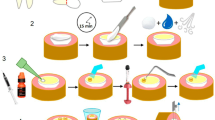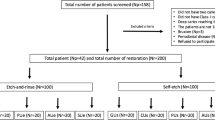Abstract
The aim of this study was to test the influence of two different cavity configurations on marginal stability of recent one bottle “etch & rinse” and “self-etch” adhesives in Class V vs. Class I cavities, before and after thermo-mechanical loading under simulation of dentinal fluid. Forty human upper molars were selected and assigned to five experimental groups. Intrapulpal pressure was maintained during cavity preparation, restoration placement, finishing and stressing. Standardized Class I and V-Shaped Class V cavities were prepared on each tooth. Half of the margins of Class V cavities were located in enamel and half in dentin. All cavities were restored with different adhesives systems and a nano-hybrid composite. Materials were light-cured using a LED unit. Restored teeth were loaded in a computer-controlled chewing machine with 1.2 million mechanical occlusal cycles simultaneously with 3,000 thermal cycles (5–50–5°C). Impressions were made with polyvinylsiloxane of each restoration before and after loading. Gold-coated epoxy replicas were prepared for SEM examination at ×200 magnification. Significant differences between materials were found both before and after loading (Kruskal–Wallis, Bonferroni, p < 0.05). Significant differences were also found between Class I and V restorations (Wilcoxon Matched-Pairs Signed-Rank Test, p < 0.05). Even before thermo-mechanical loading, none of the groups had 100% continuous margin. Marginal seal stability of recent one bottle “etch & rinse” and “self-etch” adhesives are significantly different and susceptible to cavity configuration.


Similar content being viewed by others
References
Abo T, Uno S, Sano H (2004) Comparison of bonding efficacy of an all-in-one adhesive with a self-etching primer system. Eur J Oral Sci 112:286–292
Van Meerbeek B, De Munck J, Yoshida Y, Inoue S, Vargas M, Vijay P, Van Landuyt K, Lambrechts P, Vanherle G (2003) Buonocore memorial lecture. Adhesion to enamel and dentin: current status and future challenges. Oper Dent 28:215–235
Van Meerbeek B, Vargas M, Inoue S, Yoshida Y, Peumans M, Lambretchts P (2001) Adhesives and cements to promote preservation dentistry. Oper Dent 26:S119–S144
Lopes GC, Baratieri LN, de Andrada MA, Vieira LC (2002) Dental adhesion: present state of the art and future perspectives. Quintessence Int 33:213–224
De Munck J, Van Landuyt K, Peumans M, Poitevin A, Lambrechts P, Braem M, Van Meerbeek B (2005) A critical review of the durability of adhesion to tooth tissue: methods and results. J Dent Res 84:118–132
Proenca JP, Polido M, Osorio E, Erhardt MC, Aguilera FS, Garcia-Godoy F, Osorio R, Toledano M (2007) Dentin regional bond strength of self-etch and total-etch adhesive systems. Dent Mater 23:1542–1548
Knobloch LA, Gailey D, Azer S, Johnston WM, Clelland N, Kerby RE (2007) Bond strengths of one- and two-step self-etch adhesive systems. J Prosthet Dent 97:216–222
Frankenberger R, Tay FR (2005) Self-etch vs etch-and-rinse adhesives: effect of thermo- mechanical fatigue loading on marginal quality of bonded resin composite restorations. Dent Mater 21:397–412
Giachetti L, Scaminaci Russo D, Bambi C, Grandini R (2006) A review of polymerization shrinkage stress: current techniques for posterior direct resin restorations. J Contemp Dent Pract 7:79–88
Kurokawa R, Finger WJ, Hoffmann M, Endo T, Kanehira M, Komatsu M, Manabe A (2007) Interactions of self-etch adhesives with resin composites. J Dent 35:923–929
Watts DC, Satterthwaite JD (2008) Axial shrinkage-stress depends upon both C-factor and composite mass. Dent Mater 24:1–8
Braga RR, Boaro LC, Kuroe T, Azevedo CL, Singer JM (2006) Influence of cavity dimensions and their derivatives (volume and 'C' factor) on shrinkage stress development and microleakage of composite restorations. Dent Mater 22:818–823
Nikolaenko SA, Lohbauer U, Roggendorf M, Petschelt A, Dasch W, Frankenberger R (2004) Influence of c-factor and layering technique on microtensile bond strength to dentin. Dent Mater 20:579–585
Krejci I, Stavridakis M (2000) New perspectives on dentin adhesion—differing methods of bonding. Pract Periodontics Aesthet Dent 12:727–732, quiz 734
Shirai K, De Munck J, Yoshida Y, Inoue S, Lambrechts P, Suzuki K, Shintani H, Van Meerbeek B (2005) Effect of cavity configuration and aging on the bonding effectiveness of six adhesives to dentin. Dent Mater 21:110–124
Bortolotto T, Ferrari M, Tay F, Krejci I (2007) Degradation of thermo-mechanically loaded adhesive Class V restorations after 18 months of water storage. Am J Dent 20:83–89
Bortolotto T, Ferrari M, Onisor I, Tay F, Krejci I (2005) Marginal adaptation of contemporary dentin bonding agents in enamel and dentin under the simulation of dentinal fluid. Dent S Africa 7:46–58
Krejci I, Reich T, Lutz F, Albertoni M (1990) An in vitro test procedure for evaluating dental restoration systems. 1. A computer-controlled mastication simulator. Schweiz Monatsschr Zahnmed 100:953–960
Krejci I, Kuster M, Lutz F (1993) Influence of dentinal fluid and stress on marginal adaptation of resin composites. J Dent Res 72:490–494
Heintze SD (2007) Systematic reviews: I. The correlation between laboratory tests on marginal quality and bond strength. II. The correlation between marginal quality and clinical outcome. J Adhes Dent 9(Suppl 1):S77–S106
Frankenberger R, Strobel WO, Kramer N, Lohbauer U, Winterscheidt J, Winterscheidt B, Petschelt A (2003) Evaluation of the fatigue behavior of the resin–dentin bond with the use of different methods. J Biomed Mater Res B Appl Biomater 67:712–721
Ozok AR, Wu MK, Ten Cate JM, Wesselink PR (2004) Effect of dentinal fluid composition on dentin demineralization in vitro. J Dent Res 83:849–853
Sauro S, Pashley DH, Montanari M, Chersoni S, Carvalho RM, Toledano M, Osorio R, Tay FR, Prati C (2007) Effect of simulated pulpal pressure on dentin permeability and adhesion of self-etch adhesives. Dent Mater 23:705–713
Friedl KH, Schmalz G, Hiller KA, Mortazavi F (1997) Marginal adaptation of composite restorations versus hybrid ionomer/composite sandwich restorations. Oper Dent 22:21–29
Gladys S, Van Meerbeek B, Inokoshi S, Willems G, Braem M, Lambrechts P, Vanherle G (1995) Clinical and semiquantitative marginal analysis of four tooth-coloured inlay systems at 3 years. J Dent 23:329–338
Abdalla AI, Davidson CL (1993) Comparison of the marginal integrity of in vivo and in vitro Class II composite restorations. J Dent 21:158–162
Braem M, Lambrechts P, Vanherle G (1994) Clinical relevance of laboratory fatigue studies. J Dent 22:97–102
da cunha Mello FS, Feilzer AJ, de Gee AJ, Davidson CL (1997) Sealing ability of eight resin bonding systems in a Class II restoration after mechanical fatiguing. Dent Mater 13:372–376
Tay FR, Pashley DH (2003) Water treeing—a potential mechanism for degradation of dentin adhesives. Am J Dent 16:6–12
Manhart J, Trumm C (2009) Marginal adaptation of an etch-and-rinse adhesive with a new type of solvent in class II cavities after artificial aging. Clin Oral Investig. Nov 24. [Epub ahead of print]
Hasegawa T, Itoh K, Koike T, Yukitani W, Hisamitsu H, Wakumoto S, Fujishima A (1999) Effect of mechanical properties of resin composites on the efficacy of the dentin bonding system. Oper Dent 24:323–330
Krejci I, Hausler T, Sagesser LF (1994) New adhesives in Class V restorations under combined load and simulated dentinal fluid. Dent Mater 10:331–335
Armstrong SR, Keller JC, Boyer DB (2001) The influence of water storage and C-factor on the dentin-resin composite microtensile bond strength and debond pathway utilizing a filled and unfilled adhesive resin. Dent Mater 17:268–276
Inoue S, Vargas MA, Abe Y, Yoshida Y, Lambrechts P, Vanherle G, Sano H, Van Meerbeek B (2003) Microtensile bond strength of eleven contemporary adhesives to enamel. Am J Dent 16:329–334
De Munck J, Van Meerbeek B, Satoshi I, Vargas M, Yoshida Y, Armstrong S, Lambrechts P, Vanherle G (2003) Microtensile bond strengths of one- and two-step self-etch adhesives to bur- cut enamel and dentin. Am J Dent 16:414–420
Pradelle-Plasse N, Nechad S, Tavernier B, Colon P (2001) Effect of dentin adhesives on the enamel–dentin/composite interfacial microleakage. Am J Dent 14:344–348
Yiu CK, King NM, Carrilho MR, Sauro S, Rueggeberg FA, Prati C, Carvalho RM, Pashley DH, Tay FR (2006) Effect of resin hydrophilicity and temperature on water sorption of dental adhesive resins. Biomaterials 27:1695–1703
Hosaka K, Tagami J, Nishitani Y, Yoshiyama M, Carrilho M, Tay FR, Agee KA, Pashley DH (2007) Effect of wet vs. dry testing on the mechanical properties of hydrophilic self-etching primer polymers. Eur J Oral Sci 115:239–245
Tay FR, Pashley DH (2003) Have dentin adhesives become too hydrophilic? J Can Dent Assoc 69:726–731
Moszner N, Salz U, Zimmermann J (2005) Chemical aspects of self-etching enamel–dentin adhesives: a systematic review. Dent Mater 21:895–910
Torii Y, Itou K, Nishitani Y, Yoshiyama M, Ishikawa K, Suzuki K (2003) Effect of self-etching primer containing N-acryloyl aspartic acid on enamel adhesion. Dent Mater 19:253–258
Tay FR, Pashley DH (2001) Aggressiveness of contemporary self-etching systems. I: Depth of penetration beyond dentin smear layers. Dent Mater 17:296–308
Hosaka K, Nakajima M, Yamauti M, Aksornmuang J, Ikeda M, Foxton RM, Pashley DH, Tagami J (2007) Effect of simulated pulpal pressure on all-in-one adhesive bond strengths to dentine. J Dent 35:207–213
Hashimoto M, Ito S, Tay FR, Svizero NR, Sano H, Kaga M, Pashley DH (2004) Fluid movement across the resin–dentin interface during and after bonding. J Dent Res 83:843–848
Sensi LG, Lopes GC, Monteiro S Jr, Baratieri LN, Vieira LC (2005) Dentin bond strength of self-etching primers/adhesives. Oper Dent 30:63–68
Sarr M, Mine A, De Munck J, Cardoso MV, Kane AW, Vreven J, Van Meerbeek B, Van Landuyt KL (2009) Immediate bonding effectiveness of contemporary composite cements to dentin. Clin Oral Investig. Aug 25. [Epub ahead of print]
Van Landuyt KL, Peumans M, De Munck J, Lambrechts P, Van Meerbeek B (2006) Extension of a one-step self-etch adhesive into a multi-step adhesive. Dent Mater 22:533–544
Conflict of Interest Statement
The authors declare that they have no conflict of interest.
Author information
Authors and Affiliations
Corresponding author
Rights and permissions
About this article
Cite this article
Mayoral, J.R., Gregor, L., Campos, E.A. et al. Marginal seal stability of one bottle adhesives in Class V vs. Class I cavities. Clin Oral Invest 15, 257–264 (2011). https://doi.org/10.1007/s00784-009-0372-3
Received:
Accepted:
Published:
Issue Date:
DOI: https://doi.org/10.1007/s00784-009-0372-3




